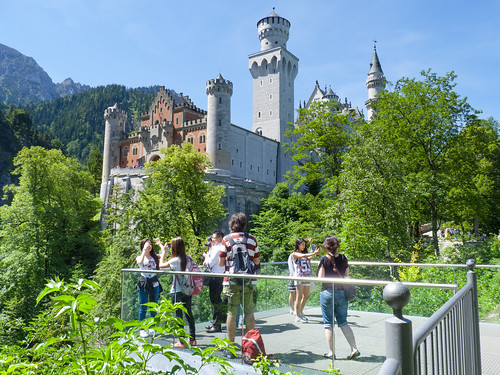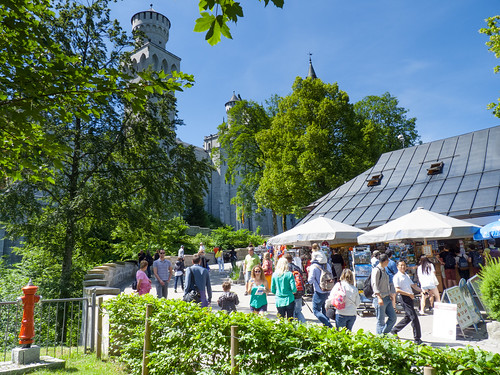Why Americans and Japanese flock to Füssen – July 2014
W e spent five nights in Füssen. We chose Füssen because previous short stops there had shown it to be an area of good walking with lakes and hills and forests. What we did not expect was . . . the Spanish Inquisition – no worse than that, what we did not expect was . . . the hordes of Japanese and American tourists. Why do Americans and Japanese flock to Füssen, rather than, say, Sedbergh? It is because Füssen has – tarran-taraaah: fairy-tale castles, notably Neuschwanstein.
On our first day whole day in Füssen we walked to Neuschwanstein, about forty minutes on a good forest path, over a bridge across a waterfall, through woods, alongside a lake and then having seen next-to no one on our pleasant undulating country walk we came to: the Neuschwanstein car park, or one of them, which was pretty-well full, in addition to which were the coaches, and the service bus from Füssen which runs every half-hour of so, is a concertina bus, and is full to standing with what seems to be entirely Japanese, though actually it isn’t entirely, just seems that way. All this activity is at the foot of the hill upon which Neuschwanstein Castle is located, and to get up the hill you can walk, take a horse-drawn carriage, or go on a shuttle bus. Each of these methods was crowded with people. We chose to walk up the hill, alongside groups of people of all manner of nationalities, and against the flow of an equal number of people coming down.
The road you walk up the hill is the same road as is taken by the horse-drawn carts, which means of course that as well as people it collects rather considerable piles of horse shit, for the carts are numerous. But this is Germany. Germany is efficient, so there is a small tractor which drives up and down the hill, towing a horse-shit collection machine. Someone’s job it is, to spend his working day hoovering up horse shit.

Selfies and friendies before the fairytale.
We did not go into the castle. It’s not that old, it was built in the late 19th century for King Ludwig II of Bavaria and has been quite heavily renovated and so is not particularly interesting, but it is a fairytale castle, see, so the people, they flock to see it. And us, we flock to see the people, and are far more amazed by what we see, than they are, I expect, by what they see.

Souvenirs and postcards before the fairytale.
One of the things that the Japanese do when in Füssen, in addition to visiting a clutch of castles and a cable-car, is to sample the local dishes. That’s what you do, if you are Japanese, you sample the local dishes. One local dish of southern Bavaria is a kind of pork shank, or hock. It’ll be the top of the lower leg of a smallish pig, the shank is roasted in the oven and should, to be genuine, have plenty of crackling – not that different in many respects from a British Sunday roast pork though with redder, somewhat juicier, or greasier, meat. It’s very good if you get a well-cooked one. It can be served with potatoes or noodles or cabbage but to be truly rustically traditional you have it with Bavarian dumplings, which are OK, but heavy and bready, a bit like eating stale bread that has been ground up and pressed into a ball somewhat bigger than a tennis ball and cooked with onions and herbs, and you’d normally get two or three of these served with your pork. Very filling.
So what the discerning traveller does is, to hang around the restaurants in Füssen on a sunny evening, when there are lots of people eating at the outside tables, and the I-Spy book 100 points is awarded when you spot a group of Japanese struggling with the pork shank and dumplings, blowing out their cheeks and sweating and mopping their brows and saying awhhh, haaagh, in an attempt to get the dumplings down their throats. Highly amusing, much more rewarding that some tarted-up castle.
No comments:
Post a Comment